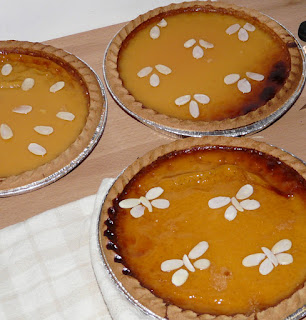(Maestre Robert "Libre del Coch" 1520, translation from "Original Mediterranean Cooking" B Santich) - redaction is my own.
Take a pound of almonds and blanch them. And grind them without adding either water or stock, so that they become very oily, and the oilier they are, the better. And take one and half pounds of white sugar, well pounded, and mix it with the almonds. And when these are mixed, if it is still a bit stiff, add a little rosewater. And season it with a little ginger, to your taste. Then take pastry made with flour and eggs and sweet oil, and fill the pastry with the sugar and the almonds. Then take oil and put it on the fire in a frying pan. And when it boils, put in the little pies, and cook them until they take on the colour of gold. And when you take them from the fire, pour over melted honey. And then sprinkle them with sugar and powdered cinnamon.
You will see that I put less sugar in than the original recipe
|
350g ground almonds 350g icing sugar 1 tsp rosewater 2 tsp ginger ½ cup wine ½ cup oil 1 egg flour; about 2 and ½ cups Caster sugar Cinnamon |

 |
While the original recipe for once does in fact give ingredients for the pastry, I played a little with it, and used a little wine in the pastry, as this gives it a wonderfully crisp texture. Mix the oil, wine and eggs, and gradually add the flour, to make a soft sticky dough. Sprinkle a board with flour, and lightly flour a rolling pin. Roll out the dough and cut out rounds. Place a little of the marzipan mixture on a round, fold in half and pinch closed (you may find that wetting the edges lightly with water will help them stick together) or run a fork around the edge.
Deep fry at 170 degrees until golden. Immediately after removing them from the oil, put them on a plate and drizzle honey over the top.
Move to drain on a draining rack (over a tray of some sort!) and then sprinkle with cinnamon and caster sugar.



